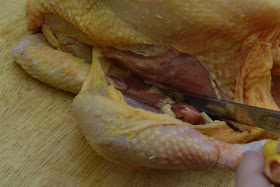Having checked my fridge and my larder, I've found a carrot, some asparagus, chicken & mushroom pate (coincidence) along with a tin of cream of chicken soup (another coincidence).
Having sorted my ingredients, I now need to portion my bird, here I'm using a small free range corn fed chicken. These birds not only look great with their yellow skin, they taste supreme too.
Place your boning knife in-between the thigh and the body of the carcass and draw your knife to the rear of the bird at the same time ensuring you cut through the ball & socket joint.
Once you have portioned the leg away from the carcass, you then need to bone out the thigh, ensuring you also take out the knee cap.
Then with a pair of poultry shears or a heavy knife, cut off the lower leg above the joint.
Tidy up any areas where sinews may potrude along with any loose attached pieces of skin.
Once you have done this, place your thumbs inside the cavity of the drumstick and push the bone until it potrudes out of the small open end.
Now place some filling into the space where the thigh bone had been along with some sitting tight up behind the drumstick bone. Here I've used some chicken & mushroom pate, but you could use some paxo stuffing or perhaps some sausagemeat, the choice is yours.
Having filled your chicken legs with your filling, place the joint inside a muffin mould or similar. Arrange so the joints sit like a pear inside the mould, if you don't have any muffin moulds then use an empty soup can like the one pictured below.
It is best that you wrap some cooking foil around the potruding bone whilst cooking as this will stop the bone turning black and unattractive. Cook for approximately 30 minutes at 180c degrees or until the juices run clear.
Once the joint has been cooked, allow the meat to rest and then proceed to slice a good piece or two off the base and then sit the main section down flat on your plate to look like a pear, add the extra slices and arrange nicely. Here I added some steamed vegetables and then finished it with the creamy chicken & mushroom soup as my sauce.
The preperation time for this Jambonneau dish was only 20 minutes including the butchery. The cooking time was 30 minutes with additional 10 minutes meat resting time, the whole dish from start to finish was only an hour.
Why don't you give this dish a go and broaden your butchery skills...
By the way, it was just a coincidence that my friends turned up with some white wine ;-)


















